Coffee is a perennial crop. Commercial Coffee farming is a decent business that gives us maximum profit. Growing strong, healthy Coffee trees involves balancing many elements: nutrients from the sun, water, wind, and soil. Helping the sale of high-quality Coffees can help restore livelihoods in areas severely affected by conflict and climate change. Let’s check out the top 20 steps to boost Coffee bean yield.
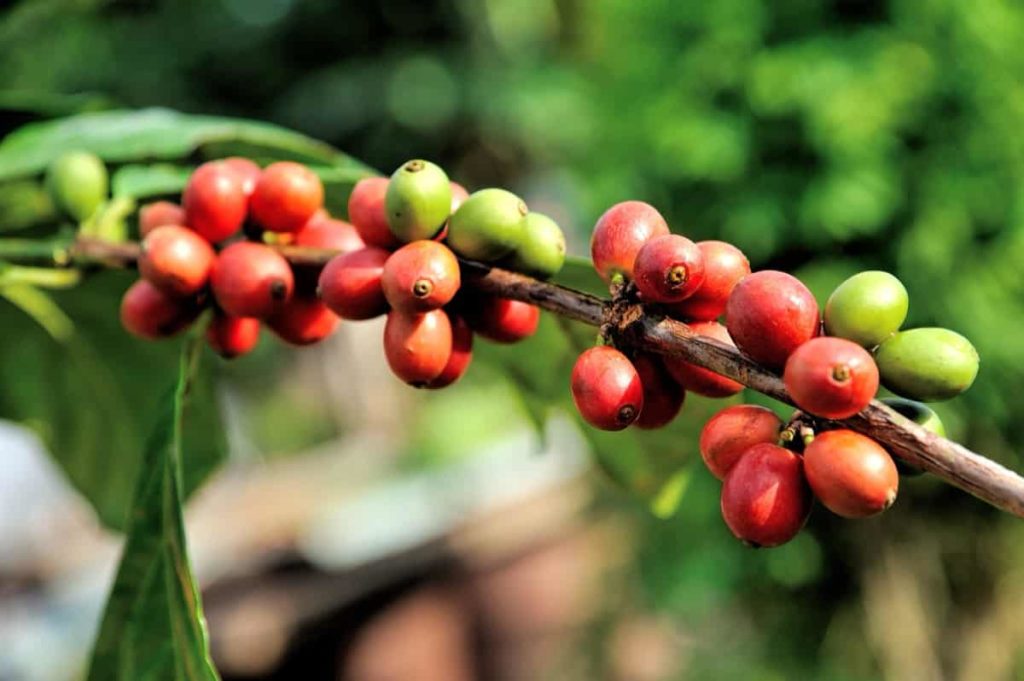
Training can be key in helping farmers to maximize sustainable farming practices and increase Coffee quality, and productivity is key for crop yield. The yield of any crop in the horticultural world depends on many factors such as soil type, climate, types, irrigation/rainfall, and garden management methods. Under ideal conditions, one can expect excellent production. Coffee Arabia yields about 400-700 kg per hectare, while Coffee Robusta yields 350-750 kg per hectare. Below are the steps that can be taken to improve the growth rate of Coffee.
Top 20 steps to boost Coffee bean yield
Step 1: Select good Coffee cultivars
The main varieties are Arabica and Robusta. They fall into different sub-categories. There are generally two main types of Coffee beans, Coffee Arabica (65%) and Coffee Robusta (35%). Coffee Arabica, which produces a fine, fragrant Coffee, requires a cooler climate than Coffee Robusta, with higher caffeine content. Therefore, the more disease-susceptible and less productive arabica plant is limited to higher altitudes, while the Robusta variety can be grown on less land, which yields higher yields.
Step 2: Suitable climatic conditions for good plant growth
The Coffee Arabica can be grown at about 900 meters to 1600 meters. It can grow at low altitudes. Growing Coffee beans at higher altitudes can delay maturation and damage the crop due to cold conditions and strong winds. The Coffee crop can grow well with an evenly distributed annual rainfall of 2,200 to 2,300 mm. Coffee crops are susceptible to high rainfall because they cause leaf rot and fungal diseases. The optimum temperature for their development is 10-20°C. Coffee orchards need shade as protection from high temperatures.
Step 3: Soil is needed for high yield and quality products
The Coffee crop has the potential to grow on a wide range of soils. However, sandy loam with good organic matter on steep mountain slopes or almost flatlands is best for cultivation. The water balance of the soil is an important factor to consider. Commercial Coffee growers should resort to soil testing methods. Any nutrient deficiencies in the soil should be addressed before starting a Coffee garden. For high-yield and quality products, the preferred pH is between 5.0 and 6.0.
In case you missed it: Best Fertilizer for Coffee Plants: Organic, Liquid, NPK, Compost Manure, and Schedule
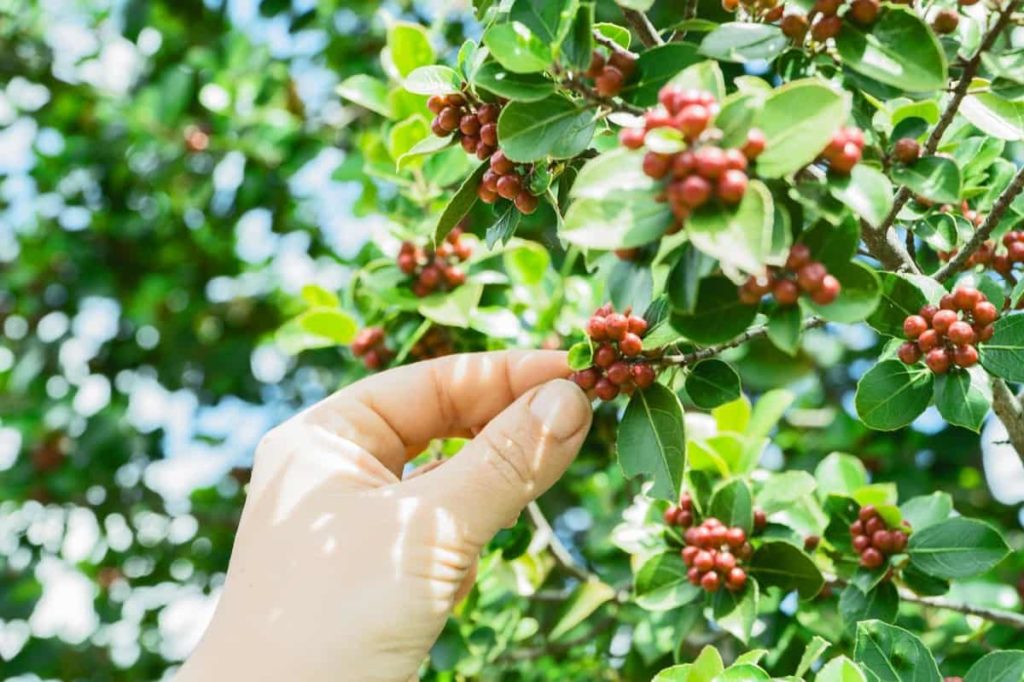
Step 4: Essential nutrients for optimum Coffee yield
The timely use of Nitrogen, Phosphorus, and Potash in required proportions ensure optimum yield. In Coffee cultivation, nitrogen, phosphorus, and potassium are important nutrients. Secondary nutrients are calcium, magnesium, and sulfur, while iron, manganese, copper, zinc, molybdenum, boron, sodium, and chlorine as micronutrients. Balanced fertilizers are all the nutrients provided in adequate amounts to maintain plant growth.
It needs that one tonne of clean Coffee yields about 34 kg of nitrogen, 5 kg of P2O5, and 45 kg of K2O in Arabica and 35 kg of N, 7 kg of P2O5, and 39 kg of K2O in the case of Robusta types. The nutrients extracted from the crop make up only one-third of the total requirements for building a healthy framework and cropping wood.
Large amounts of nutrients are also lost due to leaching during heavy rains and due to proper and dynamic nutrients in the soil. Such deficiencies can lead to soil erosion and consequent reduction in yield. So, it is important to replace the wasted nutrients with the right amount of fertilizer.
Step 5: Factors affecting Coffee production
Most Coffee production is achieved independently on dry soils where water is not restricted. Complete soil preparation before planting and maintaining pH 5.0 and 6.0; good roots and nutrients are readily available. Therefore, it is important to balance the cations in the soil at this stage.
Step 6: Crop nutrition for more production
Nitrogen is an important nutrient for strong plant growth and maintaining higher yields. The importance of nitrogen for Coffee production has been confirmed in a wide range of experiments in large Coffee producing areas.
Potassium promotes vigor, increases cell strength, and increases the Coffee tree’s tolerance to diseases and water or cold pressures. It is important to balance potassium intake with nitrogen intake, as high levels of both nutrients are required for maximum crop growth.
Phosphorus is important for early plant growth. Phosphorus foliar applications can increase Coffee yield. Calcium is required to ensure good root and leaf growth, strengthen the Coffee tree’s structure, and increase tree production. It is required by berry-fill.
Magnesium and sulfur positively affect Coffee production, and their supply should not be limited to the whole season. Zinc and boron are especially important in the flowering stage to improve the berry set and overall Coffee production capacity. Poor availability of any micronutrients will limit the growth of the Coffee plant – especially the leaf-producing areas – and reduce Coffee production.
Step 7: Importance of macro and micronutrients for the successful growth of the Coffee plant
There are 17 essential elements required for the successful growth of the Coffee plant. The nutrient deficiency can adversely affect plant growth and yield. Coffee plants get carbon, hydrogen, and oxygen from the surrounding air and water and nitrogen, potassium, phosphorus, calcium, magnesium, and sulfur from the soil where they are planted. These nine elements are called macronutrients, and the Coffee plant needs large amounts to thrive.
In case you missed it: Coffee Seed Germination, Conditions, Sowing Procedure
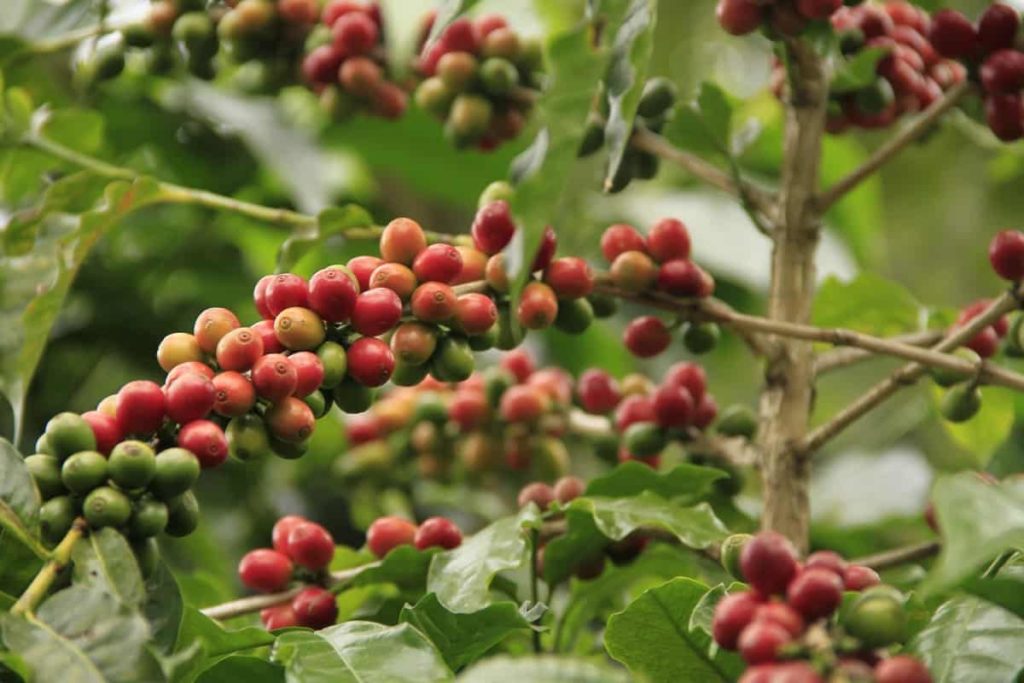
Fertilizer application time and frequency have a profound effect on growth and production. Coffee plants also need some micronutrients but in very small amounts. These micronutrients include iron, zinc, copper, manganese, boron, chlorine, and molybdenum. Some plants also need nickel.
Step 8: Crop management practices affecting Coffee yield
It will serve as a mulch to provide a source of nutrients and a return of compound pulp or trash. Good control of pests and diseases, strong root care and growth, shelters, and careful breeding ensure maximum Coffee production and fruit filling. Regular pruning is necessary to thicken the tree’s structure and grow new branches with many Coffee beans. An open canopy between the trees is necessary to ensure ripening.
Step 9: Propagation and seed treatment for better Coffee production
The Coffee crop is propagated with the help of seeds and cuttings. Make sure the selected seeds are boat-sized. Coffee berries are scraped by hand and rubbed with ashes to avoid stickiness. Coffee seeds are allowed to dry in the shade. Typically, 4,000 to 5,000 Coffee seeds must cover one hectare of land.
It is recommended to sow at a distance of 2.5 cm. It takes about 30 to 40 days for them to germinate. Growing plants should be uprooted and transplanted in polythene bags or nursery beds at 25 cm.
Seed propagation: Coffee Arabica trees are self-pollinating trees, and they usually produce true varieties of plants through seed germination. Azospirillum and Phosphobacterium can be used to treat seeds before sowing.
Vegetative propagation: High-yielding and disease-free standard plant cuttings are selected for this propagation. Disease-free varieties should be resistant to rust disease.
Step 10: Tips for getting more Coffee yield
- Water daily and do not let the soil dry out. Don’t use too much light. Coffee is an understory tree that loves bright sunlight. Lastly, always keep the temperature above freezing and keep your plants away from drafts.
- Pruning can help control plant growth and encourage vertical growth. When you are 20 inches tall, you may want to cut the top two inches of the tree, which will help promote this type of growth. If you do it right, the background branches will bloom, where you get your berries.
Step 11: Watering increases flowering and results in higher yields
Coffee trees love water, but that doesn’t mean you have to overdo it. You want to pay more attention to the soil. It should never be dry. Coffee trees grow in wet or foggy areas, so moisture is always around. Water the Coffee plant daily to keep the soil moist but not wet. Make sure your soil has proper drainage. Never let the soil dry out. Usually, it is grown as a rainfed crop.
But sprinkler irrigation during March-April increases flowering and results in higher yields. Symptoms of under watering include a shriveled stem, yellowing of the leaf, brown halo on the leaf, slight growth, and dry, crispy patches on the edges of the leaves. These problems are usually caused by too much light/heat or forgetfulness.
In case you missed it: Coffee Powder Extraction Process; Methods; Techniques
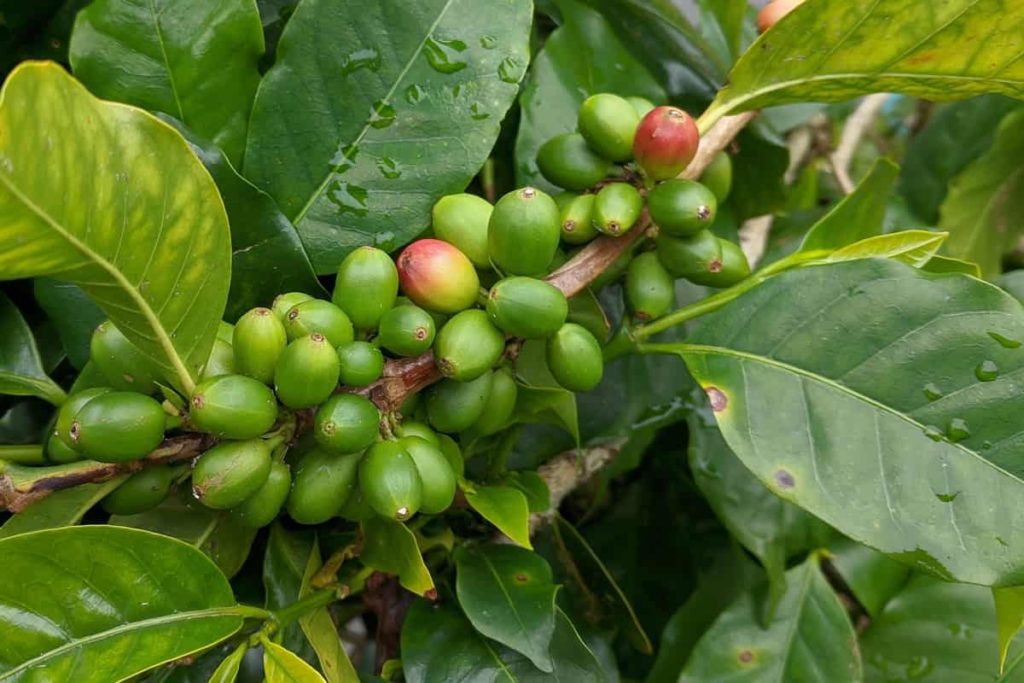
Remember, the brighter the location, the more water you will need. Keep an eye on the sun’s heat, resulting in dehydration. Symptoms of over-watering include weak or rotten stems, any new growth, yellowing of lower leaves, and plant death.
Step 12: Plant growth promoters to increase the productivity of Coffee crops
Soil management is very important for plant growth. In addition, the soil is involved in providing essential nutrients and immunity to fight diseases and prevent fungal attacks on Coffee plants. It improves soil preparation in the first stage of development; it is an important step for better production as its effect lasts longer throughout the life of Coffee plants.
There is a growing need to deal with weeds that compete with Coffee for water and nutrients and adversely affect crop yields. Various Coffee insects such as Coffee Berry Borer, Mealybugs, and Nematodes affect Coffee plants. Coffee diseases such as Coffee leaf rust, Coffee wilt, and pink disease are mostly caused by pathogenic fungi and sometimes viruses and bacteria.
Good nutrition is an excellent antidote to pests and diseases as it improves the resistance of Coffee plants. Disadvantages of using chemical pesticides include water pollution, health risks to animals and humans, and destruction of local ecosystems. Since ancient times, Coffee growers and producers have used chemical fertilizers containing nitrogen and phosphate that harm the environment in several ways, leading to long-term soil imbalances.
One of the best solutions is to use plant growth promoters in Coffee plantations. It is known to increase Coffee crop productivity. When 0.5 liters per hectare is applied, the productivity increases by 46.9%. What is special about PGP (Plant Growth Promoters) is that it helps plants grow even in difficult environmental conditions. Biological regulators increase the number of nutrients in plants and increase productivity. Better fruit sets are observed when a natural and highly efficient regulator is used to grow plants in the soil.
Step 13: Precision irrigation for more Coffee production
Precision irrigation, unlike traditional methods, one of the modern irrigation techniques, brings many benefits to Coffee growers. It is a sustainable solution to Coffee cultivation, and because of this, its acceptance is growing rapidly across the country. Here’s how precision farming helps Coffee growers.
- It helps to achieve crop uniformity.
- Increases the size of the cherry and ensures optimum crop yield.
- Helps to graduate farming from initial planting in just three years to full commercial production, thus improving return on investment.
- Provides the required amount of water and nutrients to the crop’s roots, thus avoiding nutrient deficiencies and leakage.
- Prevents water evaporation or run-off.
- The digital aspect involved in accurate irrigation helps to control agricultural activities remotely, and the availability of real information anytime and anywhere promotes fast and informed decision-making.
In case you missed it: Coffee Farming Project Report, Cost, Profits Analysis
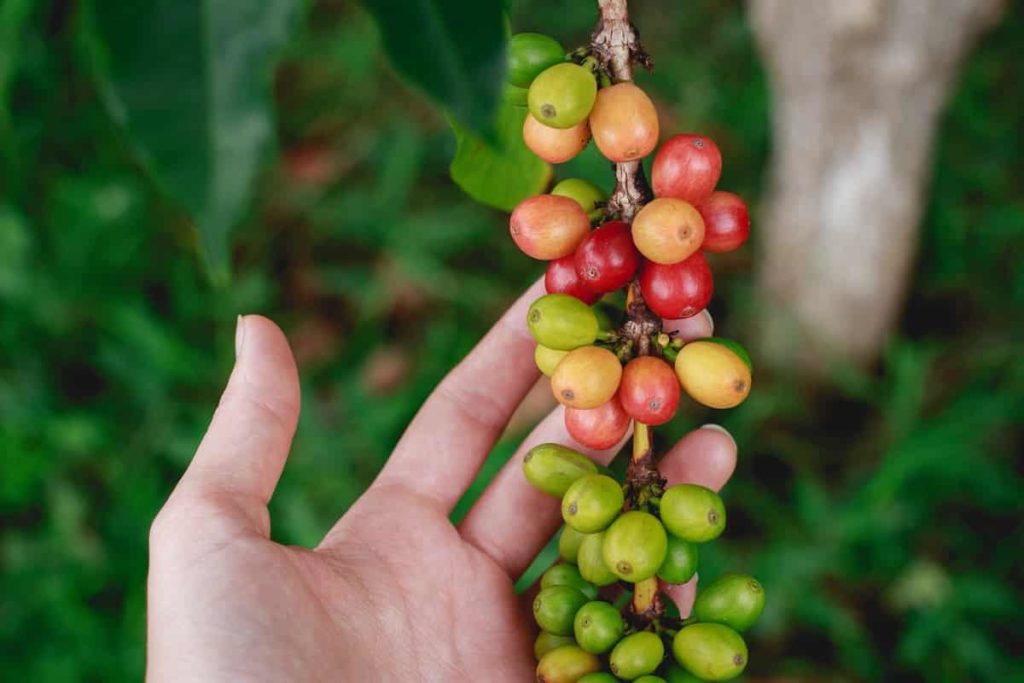
Step 14: Causes of leaves fall and yellow leaves in Coffee plant
Too much water is the first cause of falling Coffee plant leaves. Other reasons may be temperature fluctuations, drafts, and lack of moisture, usually due to being placed in an unsuitable place. Coffee plants prefer a humid environment with tropical temperatures.
Yellow leaves – The chances are that you are overwatering the plants. Reduce the watering interval and refrain from drinking too much each time.
Step 15: Limestone improves Coffee production and profits
Limestone and phosphogypsum can help improve the soil. Soil acidity and low levels of convertible calcium and magnesium are important factors limiting coffee production. The main source of calcium and magnesium is limestone. Its action can often be limited to the soil surface where it is planted.
Phosphogypsum contains calcium and sulfur. It can carry calcium deep into the soil. The use of limestone and phosphogypsum for Coffee production is one of the most important soil modification methods in other producing countries. To achieve higher Coffee yields, first improve the root environment, which helps plants make better use of soil resources.
Step 16: Causes and control brown leaves in Coffee plants
Coffee plants are good when it comes to environmental conditions. If the humidity is too low, your plant’s leaves may turn brown. Coffee leaves turn brown when exposed to too much sunlight. Sometimes, fungal diseases can turn Coffee leaves yellowish brown.
Your plant is low in humidity – The Coffee plant does not require too much humidity. If the humidity level falls below 50%, your plant will not be happy. It is because the Coffee plant relies on relative humidity for proper functioning. Similarly, evaporation allows your Coffee plant to absorb valuable nutrients from its soil.
They may contain magnesium and potassium, which strengthen the Coffee leaves. Due to the low humidity, the leaves cannot get it, which discourages evaporation. Then, they can get sick and turn brown.
You’re not giving it enough water – When your Coffee plant has nutrients and food, water distributes them easily. Without it, the leaves turn dark brown. The size of the plants also shrinks. It is the symptoms that your plant says it is dehydration and thirst.
The fungus is feeding off your plant – For everyone who grows Coffee, fungal diseases are a cause for concern. Your Coffee plant can also be attacked by nasty fungus. They radically change the color of the leaves, causing a “Coffee leaf rust” signature. The main culprit behind Coffee plant diseases is Hemileia vastatrix.
It will like to feed your Coffee plant and steal its nutrients. Fortunately, you can identify fungal problems before your Coffee leaves turn brown. As the fungus becomes more severe, it undergoes a gradual discoloration. The leaves turn orange and rusty before they turn brown.
Fungal leaf spot – Cercospora leaf spot is a common fungal disease that causes brown spots on the leaves, leaf fall, and loss of plant vigor. The spots may be surrounded by a light-yellow halo, forming an eye-like shape. Help control the disease by removing all debris and fallen leaves around the Coffee plant, as they can retain the fungus. Prune to remove some of the inner branches and allow air to circulate better in the canopy. Remove weeds from around the plant.
In case you missed it: Coffee Growing, Cultivation of Coffe – A Full Guide
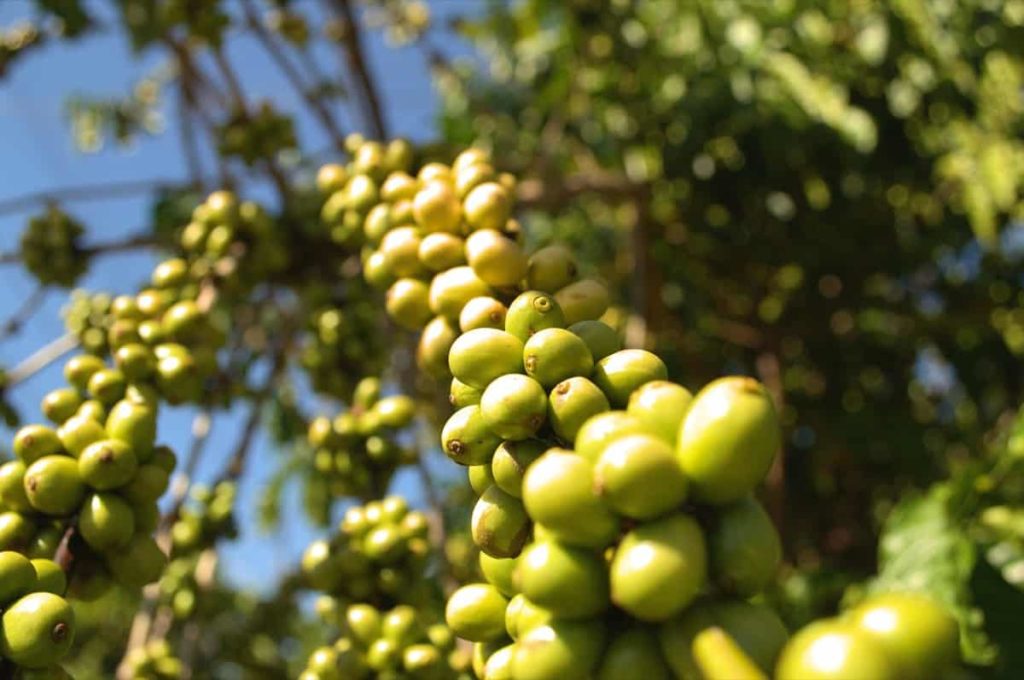
Step 17: Birds and bees increase Coffee production
Birds are important visitors to Coffee plantations because they prey on insects like the Coffee berry borer, which can otherwise damage Coffee beans or plants. In addition, pollinating insects are important for the fertilization of Coffee flowers, so they welcome visitors to Coffee farms.
Step 18: Pruning and care for Coffee plant growth
Remove yellow or dying leaves, and plant debris to encourage optimal growing conditions. When pruning, always use clean scissors or shears to reduce the chances of bacterial and fungal diseases. Never cut the yellow tissue as it can cause further damage like diseases or bacterial infections. Remember to make a clean incision as a severely damaged wound can shock the plant, causing weakened growth and declining health.
Step 19: Pests and diseases control for more plant growth
Pests commonly found in Coffee fields include Coffee berry moth, white stem borer, black Coffee stem borer, variegated Coffee bug, etc. Common diseases are Rosellinia bunodes, armillaria mellea, Coffee leaf rust, Coffeeberry disease, root rot disease, etc. Treat the infection with organic matter such as insecticides or neem oil. To prevent them from spreading to the rest of your collection as soon as possible.
Ensure the crop is properly fertilized as malnourished plants are more susceptible to disease. Remove all crop debris from the file after harvest to prevent molecular formation; a good spacing and pruning of plants to open the canopy promotes good air circulation around the plants and protects against disease. If the disease occurs, it can be controlled using copper fungicides where available.
Step 20: Harvesting tips for getting more Coffee bean yield
Harvesting depends on the specific type; the newly planted Coffee bush takes about 3-4 years to bear fruit. The fruit, commonly called cherry, varies from green to bright or dark red, depending on the degree of ripening – the raw color is green. People can cut Coffee by hand to make sure only ripe cherries are picked.
Coffee fruits should be picked when they are ripe to get better quality. Arabica comes first for harvesting because it takes 8-9 months for the fruits to develop after flowering, while Robusta takes 10-11 months. The selection is done by hand. The first picking consists of selective picking of ripe berries, which are often seen on the outer part of the node and are called fly picking. After that, there will be 4-6 major picking at intervals of 10-15 days, and the final crop, i.e., stripping, consists of picking of green berries remaining on the plant.
- Economical Aquaculture: A Guide to Low-Budget Fish Farming
- 15 Common Planting Errors That Can Doom Your Fruit Trees
- How to Make Houseplants Bushy: Effective Tips and Ideas
- Innovative Strategies for Boosting Coconut Pollination and Yield
- Pollination Strategies for Maximum Pumpkin Yield
- The Complete Guide to Chicken Fattening: Strategies for Maximum Growth
- Natural Solutions for Tulip Problems: 100% Effective Remedies for Leaf and Bulb-Related Issues
- Revolutionizing Citrus Preservation: Towards a Healthier, Greener Future
- Natural Solutions for Peony Leaf and Flower Problems: 100% Effective Remedies
- Maximizing Profits with Avocado Contract Farming in India: A Comprehensive Guide
- Natural Solutions for Hydrangea Problems: 100% Effective Remedies for Leaf and Flowers
- The Ultimate Guide to Choosing the Perfect Foliage Friend: Bringing Life Indoors
- From Sunlight to Sustainability: 15 Ways to Use Solar Technology in Agriculture
- The Ultimate Guide to Dong Tao Chicken: Exploring from History to Raising
- The Eco-Friendly Makeover: How to Convert Your Unused Swimming Pool into a Fish Pond
- Mastering the Art of Delaware Chicken Farming: Essentials for Healthy Backyard Flocks
- 20 Best Homemade Fertilizers for Money Plant: DIY Recipes and Application Methods
- How to Craft a Comprehensive Free-Range Chicken Farming Business Plan
- Brighten Your Flock: Raising Easter Egger Chickens for Beauty and Bounty
- How to Optimize Your Poultry Egg Farm Business Plan with These Strategies
- Subsidy for Spirulina Cultivation: How Indian Government Schemes Encouraging Spirulina Farmers
- Ultimate Guide to Raising Dominique Chickens: Breeding, Feeding, Egg-Production, and Care
- Mastering the Art of Raising Jersey Giant Chickens: Care, Feeding, and More
- Ultimate Guide to Raising Legbar Chickens: Breeding, Farming Practices, Diet, Egg-Production
- How to Raise Welsummer Chickens: A Comprehensive Guide for Beginners
- How to Protect Indoor Plants in Winter: A Comprehensive Guide
- Ultimate Guide to Grow Bag Gardening: Tips, Tricks, and Planting Ideas for Urban Gardeners
- Guide to Lotus Cultivation: How to Propagate, Plant, Grow, Care, Cost, and Profit
- Agriculture Drone Subsidy Scheme: Government Kisan Subsidy, License, and How to Apply Online
- Ultimate Guide to Raising Araucana Chickens: Breed Profile, Farming Economics, Diet, and Care
- Bringing Hydroponics to Classroom: Importance, Benefits of Learning for School Students
- Ultimate Guide to Raising Polish Chickens: Breed Profile, Farming Economics, Diet, and Care
- Ultimate Guide to Raising Australorp Chickens: Profile, Farming Economics, Egg Production, Diet, and Care
- Silkie Chicken Farming: Raising Practices, Varieties, Egg Production, Diet, and Care
- Sussex Chicken Farming: Raising Practices, Varieties, Egg Production, Diet and Care
- Homemade Feed Formulations for Livestock: Discover Cost-effective Starter to Finisher Feed Recipes
Good evening, thanks for your comments,am learning something about coffee farming.
It’s a good guide to small farmers.
It’s a request to have workshops in various region’s
It’s also good to have more extension officer’s.
THANKS ., i have learnt a lot from this forum , i wish we could have extensional agricultural officers nearer to the farmers.
I learnt a lot. Thanks
Right spacing for coffee plant
Thanks for the blog loaded with so much information. It’s really informative.